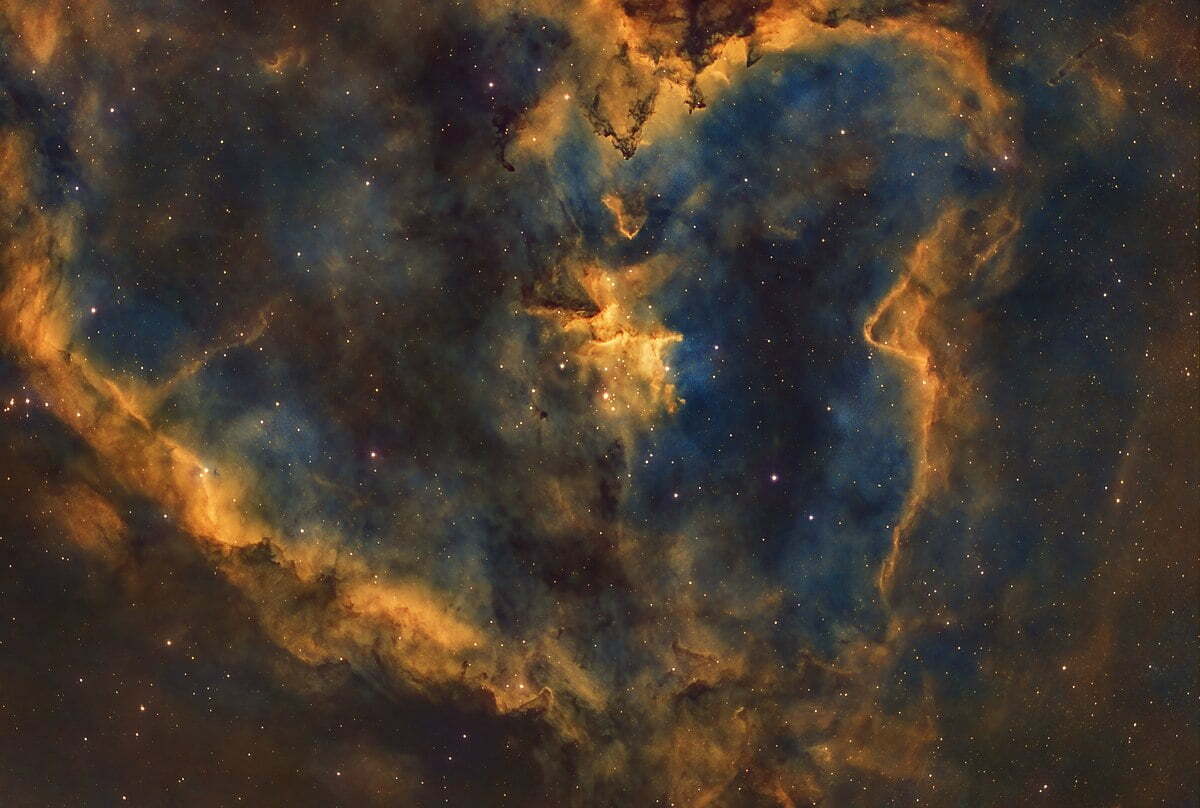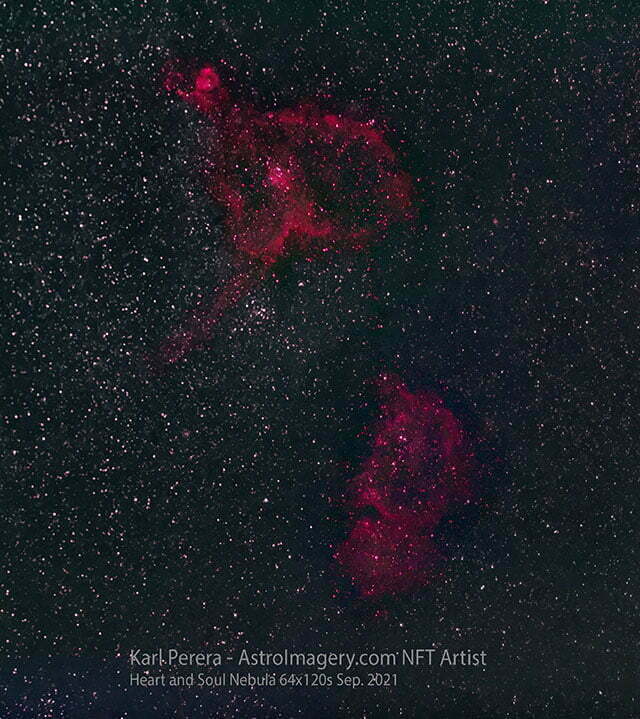Table of Contents
Since I got interested in Astrophotography one of my top targets has been the Heart Nebula. I saw the wonderful images of it and this convinced me that I needed to start photographing emission nebulas such as this. But beyond imaging this wonder, what exactly is this region of space and how did this stunning nebula come about?
The Heart Nebula is an emission nebula in the constellation of Cassiopeia. The nebula is usually quite high in the sky so it can be imaged without much effect from light pollution. The nebula has a mass of stars at its center but is quite faint and requires hours of exposure to uncover the detail.
Very close to the Heart Nebula is its close companion the Soul Nebula. They are often photographed together as one amazing image, especially with wide-field cameras that have a sufficiently large field of view to fit both nebulae in the same shot.
One thing that does stand out when you are imaging this nebula is the concentration of bright stars at the center of the Heart Nebula, which got me thinking about why this is so and what might be going on there. We’ll come back to this in just a bit. But first, let’s take a look at some of the facts about this amazing deep sky object that so many seek to image through their telescope or camera lens.
The History of the Heart Nebula
In 1787, astronomer William Herschel discovered this nebula when he was observing a comet near it.
In 1864, English astronomer Lord Rosse used his giant telescope at Birr Castle in Ireland to observe the Heart Nebula and classified it as open cluster M52.
Robert Burnham Jr., an American astronomer who published his observations in 1879, called it “Hertzsprung spot”, after a Danish physicist that he admired.
Later on, in 1920, a team of astronomers led by British astronomer John Graham Chambers discovered that the nebula is actually a supergiant star with a massive stellar wind blowing out from its surface.

The Heart Nebula – What is it?
It is an emission nebula in the constellation of Cassiopeia. It is a stellar nursery where stars are born.
This Nebula is a complex nebula in the center of the Milky Way Galaxy, part of one of the largest star-forming regions. It is also known as IC 1805.
Stars form in nebulae from large clouds of gas and dust – sometimes they will form a giant molecular cloud with a mass 100 times greater than our Sun’s. As these clouds collapse under their own gravity, clumps will start to develop and eventually become dense enough to create hydrogen fusion reactions – which then lead to their birth as new stars.
William Herschel called it the “Herschel Nebula” or “H II region 1805”. When observed later, astronomers discovered that it was not a single nebula but many different nebulae along with an open cluster of stars, hence its current name. The density and size vary across this large region and so do the number and kind of stars inside it.
The heart nebula is one of the most iconic images in space. But the Soul Nebula is right “next door” and the two can be captured nicely together as I did this year:

The image I created above was taken with my Canon 600D modified and a Samyang 135mm lens on my CEM 26 ioptron mount. It is a stacked version from 64 two-minute exposures at ISO 800. I plan to add Hydrogen Alpha data to this and will post that image here when it is done.
Watch this video from Windy City Astrophotography to follow an imaging session of the Heart Nebula.
The reason it gets its name is that it clearly has the shape of a heart when viewed from Earth (see my image above).
The nebula can be seen with a small telescope, or even through a lens as above, in both the northern and southern hemispheres.
What Makes the This Nebula So Unique?
The nebulosity in this area is mostly due to the gases and dust particles that are heated by the radiation from a hot, massive star at its center. The central star has a mass approximately 18 times that of our sun and is one of the hottest stars in our galaxy.
The scattered red-colored light from the central star eventually makes its way to Earth where it appears as an ethereally red hue.
The Heart Nebula has an approximate size of 20 light-years across and contains ionized hydrogen (H II), meaning that it is emitting energy into space through the process of nuclear fusion due to the temperature and density of the gas inside it. The nebular’s large size makes it an easy target for telescopes, which can see details within its form even when they are looking at other galaxies in space. see an example of one image that contains many galaxies taken with my medium-sized telescope.
Here is an amazing smart telescope that will enable you to image this nebula and much more:
This structure appears pink when observed because its gases are excited by radiation from nearby, hot stars outside our view at visible wavelengths.
The nebula is made up of ionized hydrogen gas, with large amounts of dust that give it its distinctive red hue.
There are open clusters of new stars being formed in the region, but most are hidden behind the dust.
Experts believe that the nebula contains at least two generations of stars.
Bubbles can be seen forming around some of these stars as they eject material into space.
The Heart Nebula is a large, complex interstellar cloud that contains a star-forming region. The nebula is about 3.5 light-years in diameter and has an estimated mass of 10,000 suns.
The most distinguishable feature of the Nebula is the bright red protrusion known as the “Heart” which can be found in the lower left-hand corner of its shape.
It is located in the constellation Cassiopeia which is often called “the Queen” because it appears to be seated on her throne or chair in the northern sky.
This Nebula is one of the most studied nebulae in space due to its simplicity and beauty. Scientists have been fascinated with it for decades because they are trying to determine what causes this amazing phenomenon. It’s believed that these stars are interacting with each other which creates the purple, blue, and white glow on it. They also believe that some interstellar clouds are also in the picture too.
How Did the Heart Nebula Form?
In the heart of it lies a young, hot star cluster called NGC 896. It is only about 2 million years old and contains many very massive, hot stars that are short-lived and violently eject material from their surfaces at a great rate. This material surrounds the cluster in a thick cloud called a molecular cloud. As it collides with cool gas inside the cloud, shock waves form and emit light which we see as this beautiful nebula’s delicate tendrils of gas and dust.”
The nebula is created by the radiation from three stars.
It is classified as an emission nebula because its atoms emit light due to excitation by nearby stars. These stars are mostly blue giants and supergiants that cause ultraviolet radiation to flow from their cores, which excite hydrogen atoms. The process by which this happens is called fluorescence. The electrons then emit photons with a wavelength of visible light that we can see, giving off a red color.
The birth of this nebula is not clear. Some say it is a dying star, others say it is an explosion of gas. Nevertheless, what is known for sure is that it takes on the shape of a human heart because this nebula has the same chemical composition as our own sun.
The UV radiation from the central star heats up these particles to a point where they emit atomic hydrogen electrons they have just absorbed from nearby gas molecules. This creates a pillar-like structure that’s around fifteen light-years long. Around this pillar, you can see pillars of cold dust and molecular hydrogen.
It is believed that the nebula was formed by a supernova that occurred 10,000 to 20,000 years ago. The star that exploded was about 15 times more massive than the Sun.
The heart nebula is a well-known star formation, and it’s even visible to the naked eye in very dark night skies.
It’s one of the nearest and most easily discernible regions of recent star formation in the night sky.
There are only about five hundred stars in total within this region, but they all release enough radiation to ionize the hydrogen gas around them and produce an emission spectrum that we can see on Earth.
How Far Away is it?
The Heart Nebula IC 1805 is an emission nebula in the constellation of Cassiopeia, around 7500 light-years away.
We can’t really say when this nebula will die or how fast it’s expanding because we can’t really see its inner regions.
What is at the Centre of the Heart Nebula?
In the center of the nebula, there is a star cluster, named Melotte 15. This cluster produces winds and light that create some of the effects of the nebula. Millions of years in the past a microquasar was expelled from this zone, according to Nasa.
There is also a bright star in the center. This star is at least double or triple as hot as our sun. In fact, it’s so hot that its ultraviolet radiation ionizes the atoms in nearby clouds of gas and dust particles.
How to Image the Nebula
It is possible to image the whole of the heart nebula with the correct field of view, either using a telescope and camera or a camera with a suitable lens. The lens I used for both the Soul and Heart Nebula had a field of view of 135mm and I have also attempted to photograph them alone using my telescope which has a field of view of 650mm. The Heart Nebula looks a bit squashed in 650mm, so I would recommend shooting it at about 500mm if you can.
This would be a great telescope to use to capture the heart nebula:
I have found that, as with most emission nebulae, at least three hours of exposure is best to get a good image. Also, it is better to go for at least 60-second exposures or longer if you can. Use a light suppression filter if you can. In processing, you may need to dim the stars and there are many different ways to do this as we shall see elsewhere on this website.
After all the photographic work comes the processing for which we need software programs such as Photoshop and some kind of stacking program, I generally use Sequator for this.








